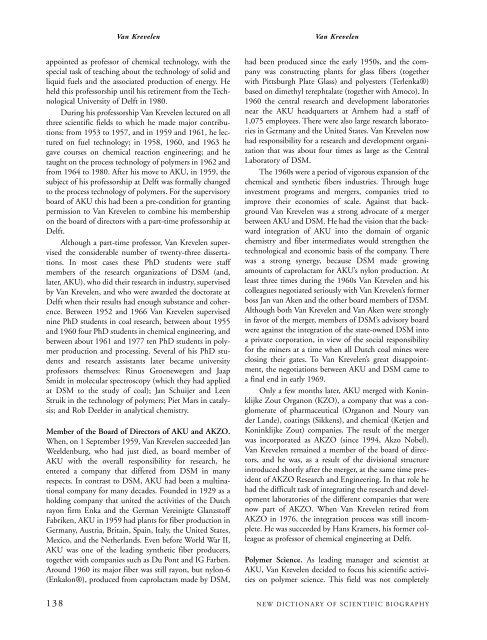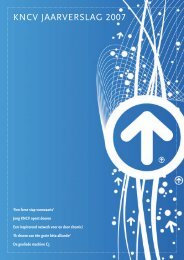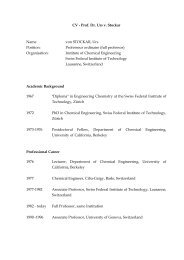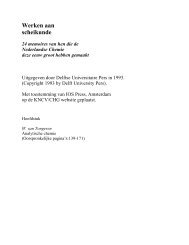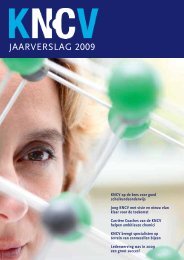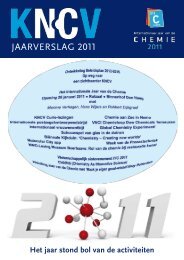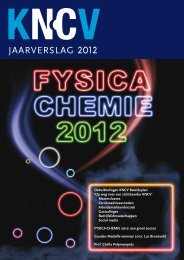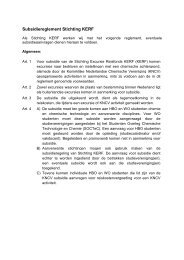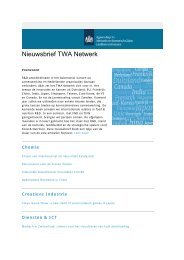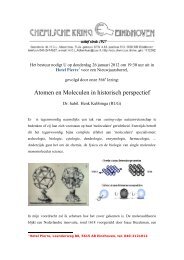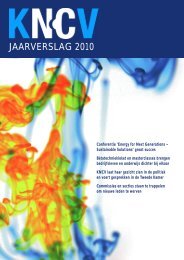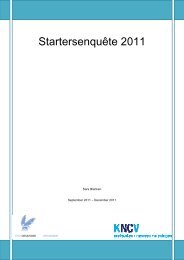VAN GOORLE, DAVID VAN KREVELEN, DIRK WILLEM (b. - KNCV
VAN GOORLE, DAVID VAN KREVELEN, DIRK WILLEM (b. - KNCV
VAN GOORLE, DAVID VAN KREVELEN, DIRK WILLEM (b. - KNCV
You also want an ePaper? Increase the reach of your titles
YUMPU automatically turns print PDFs into web optimized ePapers that Google loves.
ndsbv7_V 9/27/07 2:59 PM Page 138Van KrevelenVan Krevelenappointed as professor of chemical technology, with thespecial task of teaching about the technology of solid andliquid fuels and the associated production of energy. Heheld this professorship until his retirement from the TechnologicalUniversity of Delft in 1980.During his professorship Van Krevelen lectured on allthree scientific fields to which he made major contributions:from 1953 to 1957, and in 1959 and 1961, he lecturedon fuel technology; in 1958, 1960, and 1963 hegave courses on chemical reaction engineering; and hetaught on the process technology of polymers in 1962 andfrom 1964 to 1980. After his move to AKU, in 1959, thesubject of his professorship at Delft was formally changedto the process technology of polymers. For the supervisoryboard of AKU this had been a pre-condition for grantingpermission to Van Krevelen to combine his membershipon the board of directors with a part-time professorship atDelft.Although a part-time professor, Van Krevelen supervisedthe considerable number of twenty-three dissertations.In most cases these PhD students were staffmembers of the research organizations of DSM (and,later, AKU), who did their research in industry, supervisedby Van Krevelen, and who were awarded the doctorate atDelft when their results had enough substance and coherence.Between 1952 and 1966 Van Krevelen supervisednine PhD students in coal research, between about 1955and 1960 four PhD students in chemical engineering, andbetween about 1961 and 1977 ten PhD students in polymerproduction and processing. Several of his PhD studentsand research assistants later became universityprofessors themselves: Rinus Groenewegen and JaapSmidt in molecular spectroscopy (which they had appliedat DSM to the study of coal); Jan Schuijer and LeenStruik in the technology of polymers; Piet Mars in catalysis;and Rob Deelder in analytical chemistry.Member of the Board of Directors of AKU and AKZO.When, on 1 September 1959, Van Krevelen succeeded JanWeeldenburg, who had just died, as board member ofAKU with the overall responsibility for research, heentered a company that differed from DSM in manyrespects. In contrast to DSM, AKU had been a multinationalcompany for many decades. Founded in 1929 as aholding company that united the activities of the Dutchrayon firm Enka and the German Vereinigte GlanzstoffFabriken, AKU in 1959 had plants for fiber production inGermany, Austria, Britain, Spain, Italy, the United States,Mexico, and the Netherlands. Even before World War II,AKU was one of the leading synthetic fiber producers,together with companies such as Du Pont and IG Farben.Around 1960 its major fiber was still rayon, but nylon-6(Enkalon®), produced from caprolactam made by DSM,had been produced since the early 1950s, and the companywas constructing plants for glass fibers (togetherwith Pittsburgh Plate Glass) and polyesters (Terlenka®)based on dimethyl terephtalate (together with Amoco). In1960 the central research and development laboratoriesnear the AKU headquarters at Arnhem had a staff of1,075 employees. There were also large research laboratoriesin Germany and the United States. Van Krevelen nowhad responsibility for a research and development organizationthat was about four times as large as the CentralLaboratory of DSM.The 1960s were a period of vigorous expansion of thechemical and synthetic fibers industries. Through hugeinvestment programs and mergers, companies tried toimprove their economies of scale. Against that backgroundVan Krevelen was a strong advocate of a mergerbetween AKU and DSM. He had the vision that the backwardintegration of AKU into the domain of organicchemistry and fiber intermediates would strengthen thetechnological and economic basis of the company. Therewas a strong synergy, because DSM made growingamounts of caprolactam for AKU’s nylon production. Atleast three times during the 1960s Van Krevelen and hiscolleagues negotiated seriously with Van Krevelen’s formerboss Jan van Aken and the other board members of DSM.Although both Van Krevelen and Van Aken were stronglyin favor of the merger, members of DSM’s advisory boardwere against the integration of the state-owned DSM intoa private corporation, in view of the social responsibilityfor the miners at a time when all Dutch coal mines wereclosing their gates. To Van Krevelen’s great disappointment,the negotiations between AKU and DSM came toa final end in early 1969.Only a few months later, AKU merged with KoninklijkeZout Organon (KZO), a company that was a conglomerateof pharmaceutical (Organon and Noury vander Lande), coatings (Sikkens), and chemical (Ketjen andKoninklijke Zout) companies. The result of the mergerwas incorporated as AKZO (since 1994, Akzo Nobel).Van Krevelen remained a member of the board of directors,and he was, as a result of the divisional structureintroduced shortly after the merger, at the same time presidentof AKZO Research and Engineering. In that role hehad the difficult task of integrating the research and developmentlaboratories of the different companies that werenow part of AKZO. When Van Krevelen retired fromAKZO in 1976, the integration process was still incomplete.He was succeeded by Hans Kramers, his former colleagueas professor of chemical engineering at Delft.Polymer Science. As leading manager and scientist atAKU, Van Krevelen decided to focus his scientific activitieson polymer science. This field was not completely138 NEW DICTIONARY OF SCIENTIFIC BIOGRAPHY


